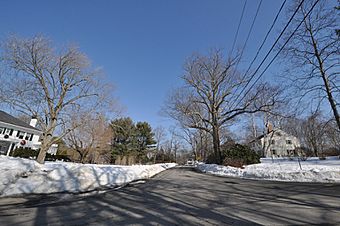Jewell Town District facts for kids
Quick facts for kids |
|
|
Jewell Town District
|
|
 |
|
| Location | W. Whitehall Rd. and Jewell St., South Hampton, New Hampshire |
|---|---|
| Area | 78.9 acres (31.9 ha) |
| Built | 1687 |
| Built by | Multiple |
| Architectural style | Mixed (more Than 2 Styles From Different Periods) |
| MPS | South Hampton MRA |
| NRHP reference No. | 83001147 |
| Added to NRHP | April 11, 1983 |
The Jewell Town District in South Hampton, New Hampshire, is a special historic area. It was once a busy village with many factories, called "mills," that used water power. This area started way back in 1687! It's located where West Whitehall and Jewell Streets meet, near the Powwow River. The river's strong current helped power the old mills.
Thomas Jewell settled here in 1687. Over time, many different mills and even an iron factory were built. Today, you can still see old homes from the 1700s and early 1800s. This district was added to the National Register of Historic Places in 1983.
Contents
Exploring Jewell Town Today
Jewell Town is located in the southern part of South Hampton. It sits right next to the state line with Massachusetts. Today, it's mostly a quiet, rural area. You'll find lots of farmland and forests here.
The historic district covers about 79 acres. It stretches along West Whitehall Road. The busiest part of the district is where West Whitehall Road meets Jewell Street. This spot is between two bridges over the Powwow River.
Historic Homes and Buildings
As you travel along West Whitehall Road, you'll see many houses. These homes were built between 1740 and the 1900s. Most of them are made of wood. They are usually one to two-and-a-half stories tall.
Many of the older homes were built before 1850. They show styles like Colonial, Federal, and Greek Revival. Later houses have simpler designs. There is also one house from the early 1900s in the Colonial Revival style.
A Look at Jewell Town's Past
The Jewell Town area was first settled in 1687 by Thomas Jewell. People quickly realized that the Powwow River could provide great power. The bend in the river became the main spot for industries in South Hampton during the 1700s.
Early Industries and Mills
Many different businesses operated here. There were several sawmills, which cut wood into lumber. A gristmill ground grain into flour. A fulling mill cleaned and thickened wool cloth. There was also an iron works, which made things from iron.
In the 1800s, more specialized factories appeared. These included businesses that made pails, matches, and axles for wheels.
The End of Water Power
The water-powered industries in Jewell Town eventually stopped. A company called Salisbury Mill Company, located nearby in Amesbury, Massachusetts, bought all the water rights. This meant they owned the right to use the river's power. They kept it for their own factories. This made it impossible for the mills in Jewell Town to keep running.



